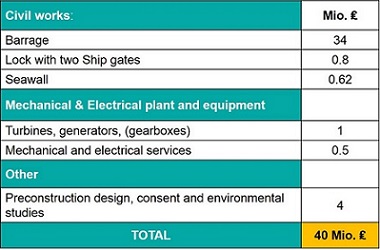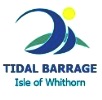IMPACT ASSESSMENT
Economic Impacts
Tourism
The construction of the barrage will have vast implication, both positive and negative. The visual impact on is significant therefore could alter visitor’s outlook of the areas, or also become a main attraction site on its own.
Recreational sailing
The challenges posed to the recreational activities increase as the bay will be only accessible within a given time period and this potentially rises pile-up between vessels as the race to enter the harbour. Our proposed solution is a shipgate which reduces the pressure on the accessibility of the harbour. During construction time we propose a sequence construction. This means that the barrage is constructed in parts leaving one side always accessible to vessels.
Fishery
The presence on the barrage will also restrict vessels movement within the vicinity of the port. Notably disturbing commercial fishing vessels journeys, offloading only during low power generation periods.
Land and housing quality
This project could potential affect retail values of the houses available within its surrounding areas. Already, half the homes are holiday dwellings and prices will either decrease if the barrage is deemed an eyesore or increase in value if potential residents are able to get reduced tariff for their energy use.
Ecological Impacts
Coastal processes and sediment transport
Variation in changes to the hydrodynamic and wave conditions and sediment transport and flow speeds. The levels of high water and low water inside the Lagoon are predicted to change during the operation phase, with high water levels being lowered and low water levels being raised. Increased speeds in the lee of the turbines and decreased speeds across the shallow sub-tidal and intertidal region (towards the back of the Lagoon) as a result of the sheltering effects of the Lagoon walls.
Water quality
During construction, some residual contamination might occur but this deemed as having short-term effect on the water quality. Whereas long-term consequences of water quality are low due to the fresh water interweaving across the barrage.
Benthic ecology
Potential effects on marine plants and animals during the construction, operational and decommissioning. Loss and change in available habitat extent and a change in both the physical processes and water quality.
Coastal birds, fish and mammals
Initial habitats could be lost and disturbed but some projects have proven to benefit all forms of life in the surrounding ecosystem as well. With the installation of so called fish-friendly turbines the danger of harming fish can be reduced.
Seascape and landscape visual impact assessment (SLVIA)
During operation, effects on seascape and landscape character are predicted to be direct and significant from locations within or immediately adjacent to the Project boundary. Along the coastline several walking paths are located which could be affected by the barrage. The barrage is only partially visible during low water from the harbour and the village centre itself.
LEGAL FRAMEWORK
Planning and Construction of the Barrage
This section discusses the main legal framework and legislation which applies to our propose project.
Terrestrial planning:
Onshore works above MLWS are planned according to regional planning regulations under Section 57 of the Town and Country Planning (Scotland) Act 1997.
Marine planning:
Marine works are mainly subjected to two regulations:
- UK Marine and Coastal Access Act 2009 and the Marine (Scotland) Act 2010
Marine Scotland’s Licensing Operations Team (MS-LOT) is responsible, under the Marine (Scotland) Act 2010 and Part 4 of the UK Marine and Coastal Access Act 2009, for issuing a Marine Licence. A Marine Licence is required for any of the following activities:
- Deposit of any substance or object in the sea or on or under the seabed.
- Construction, alteration, or improvement of works on or over the sea or on or under the seabed.
- Removal of substances or objects from the seabed.
- Dredging.
- Deposit of and/or use of explosives.
- Incineration of substances or objects.
A Marine Licence is therefore necessary for the proposed development and seabed lease must be obtained from the Crown Estate before construction.
- Section 36 of the Electricity Act 1989 with deemed permission under Section 57 for generation sites and/or Section 28 of the Town and Country Planning (Scotland) Act 1997 (for onshore construction).
“Section 36 of the Electricity Act 1989 requires consent from Scottish Ministers to construct, extend or operate an onshore electricity generating station exceeding offshore generating stations over 50 MW in the Scottish Renewable Energy Zone (REZ) and over 1 MW within Scottish territorial waters. Marine Scotland’s Licensing Operations Team (MS-LOT) is responsible for issuing consent for renewable energy projects under Section 36 of the Electricity Act 1989.” SOURCE
Grid connection
It is advised to contact the local distribution network operator to discuss the marine generation scheme and the connection arrangement. The following legislation is helpful regarding the grid connection.
- The Distribution Code (2008)
- The Electricity Act (1989)
Legislation and Guidance for environmental related subjects
An Environmental Impact Statement is necessary when: “The development falling within a description in Schedule 1 to the 2011 EIA Regulations always require EIA. Development of a type listed in Schedule 2 to the 2011 EIA Regulations will require EIA if it is likely to have a significant effect on the environment, by virtue of factors such as its size, nature or location. The development falls under the as required by the Electricity Works (Environmental Impact Assessment) (Scotland) Regulations 2000”. SOURCE
A licence could be necessary to disturb European Protected Species (EPS) under the European Habitats Directive (92/43/EEC) and Birds Directive (79/409/EEC).
CONSULTANTS
We have identified the following consultants for the above mentioned impacts. This list provides just an overview and is by far not complete.
The main consultant is Marine Scotland, which is the authority for offshore developments in Scottish Territorial Waters and regional and local authorities, which is in our case the Dumfries and Galloway Council and the Isle of Whithorn Community Council, which should be contacted throughout the application process.
Other important parties for environmental, cultural heritage, marine navigational and commercial related issues are:
Environmental
- Scottish Environment Protection Agency (SEPA)
- Scottish Natural Heritage (SNH)
- Royal Society for the Protection of Birds (RSPB)
Cultural Heritage
- Historic Scotland
- The National Trust for Scotland
Commercial Fishery
- Scottish Fishermen’s Federation (SFF)
- Local fishery authorities
The Northern Lighthouse Board
- Maritime and Coastguard Agency (MCA)
- The Royal Yachting Association (RYA)
- Local Harbour Master
COST
The cost estimation shown in the table below is based on government case studies and comparisons to the components that comprise our project. The dominant cost is civil works, at 34 million pounds, with the overall cost being 40 millions. Because this table is based on other case studies and their approch to cost, further investigation could be needed.

Funding Options
As a public and local project with an enormous amount of backing required, it is hard to justify the project financially and expect the local council to accommodate most of the funds. Therefore various routes are being considered as to provide assistance in raising potential funds.
Various organisations and schemes are therefore willing to invest in renewables energy projects and hence, might be able to consider such a project; these organisations are listed below:
CONTRACTS FOR DIFFERENCE (CFD) - Provides price stabilisation to low carbon plant, allowing investment at a subordinate cost and at a lower cost to consumers.
LOCAL ENERGY SCOTLAND – Provides a scheme called the local energy challenge fund; which is an exciting Scottish Government programme supporting a transition to a different approach to energy generation and consumption.
National Lottery fund (renewable energy) – This plan is jointly run and subsidized with the collaboration of the Department of Trade and Industry and the Department of Environment, Farming and Rural Affairs. The grants are awarded to renewable type projects and councils across the UK.
DEMAND
To estimate the demand of the Isle of Whithorn we take an approximate maximum electricity use for 1 home, at 2 kW. This number was derived from an estimation of the electricity usage for electrical heating, as most of the residences on the Isle of Whithorn use electrical heating for primary heating. Therefore, for 100 homes the maximum power demand was estimated at 200 kW.
For our tidal barrage, that consists of 4 turbines of 1.7m with maximum peak power production each of 245 kW, we have a maximum power production of 980 kW. So, that gives us enought power (during maximum production only) to cover the demand of the village and export the rest to the grid.
However, the grid in the area is rather weak and the circuit is saturated, and no generation in excess of 100kW can be connected at the moment. In that case, when we have excess of power (at low demand - high production) and it is not possible to transfer the power to the grid, we would be forced to either dump the excess energy or find a way to store it.
There is a plan for future work to upgrade the grid capacity, and in that event our tidal barrage could be fully exploited to its maximum capacity and become a great source of renewable energy production.





